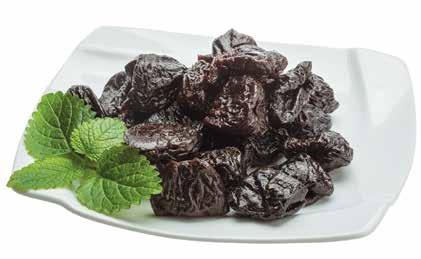
13 minute read
health briefs
Avoid Living Near a Fracking Facility
The 17.6 million Americans living within one kilometer of one of the country’s 100,000 hydraulic fracturing (fracking) facilities face a higher risk of heart problems, cancer and respiratory disease, recent research suggests. In the latest study from Harvard, statisticians found that living near or downwind from a fracking site contributes to earlier death among elderly people. Combining the Medicare records of 15 million people over age 65 with zip codes of fracking wells, they found that the closer to the wells people lived, the greater their risk of premature mortality. Those that lived closest had a statistically significant elevated mortality risk (2.5 percent higher) compared with those that didn’t live close by, and those living downwind faced a higher risk of premature death than those upwind. The results suggest that airborne contaminants emitted by the wells are contributing to the increased mortality, the researchers write.

Eat Prunes and Anti-Inflammatory Food to Reduce Bone Loss and Fragility
A popular staple since ancient times, prunes have long been esteemed for their culinary, nutritional and medicinal purposes, and a new review of research has found that they can also help counter the bone loss linked to fragility in postmenopausal women. After reviewing 28 studies, Penn State University researchers reported in the journal Advances in Nutrition that eating five to 10 prunes each day can help prevent or delay bone loss, lowering the risk of fractures. In one study, women that ate 100 grams of prunes (about 10) per day for one year experienced improved bone mineral density in their forearms and lower spines. In another study, eating five to 10 prunes a day for six months was shown to prevent bone density loss and decrease TRAP-5b, a bone-loss marker. The nutritional benefits of prunes, including minerals, vitamin K, phenolic compounds and dietary fiber, may reduce the inflammation and oxidative stress that contribute to bone loss, said the authors.
In a separate study in the American Journal of Clinical Nutrition, Harvard Medical School researchers that studied 1,700 older adults for 12 years found that those that ate a highly pro-inflammatory diet rich in simple carbohydrates and saturated fats were more than twice as likely to develop fragility—increasing the risk of falls, hospitalization and death—as those eating the least amount of those sweet, fatty foods.
Try Tai Chi to Boost Neurological Health
With its slow, rhythmic, controlled movements and synchronized, deep breathing, the ancient Chinese practice of tai chi has been shown to improve balance, reduce falls and enhance the quality of life for people with neurological challenges such as strokes,
Parkinson’s disease and multiple sclerosis. A meta-review of 24 studies by researchers at the University of North Texas Health Science Center concluded that tai chi may be able to reduce pro-inflammatory contributors to cellular activity, increase anti-inflammatory cytokines that help regulate immune response, decrease oxidative stress factors and increase neurotrophic factors regulating neural health. Researchers pointed to its “potential effectiveness in neurorehabilitation,” which aims to improve the functions and well-being of people with diseases, trauma or disorders of the nervous system.
An Ancient Staple of Health Goes Mainstream
May 21 is International Tea Day. The popularity of tea in the U.S. is growing rapidly, and the environmental and health benefits of tea production and consumption are greater than those of coffee. Tea has an infinite variety of flavors, colors and fragrances that make it a fascinating choice. Exploring the many aspects of tea can be a surprisingly delicious and enlightening experience.
Tea has less caffeine than coffee per serving. Although it has more caffeine than coffee per pound, it takes only one gram of tea to make one cup of tea, whereas it takes about five to 10 times more weight in beans to make one cup of coffee. Also, tea contains L-theanine, a chemical that works synergistically with caffeine to promote a balanced energy boost.
Tea is the most popular prepared beverage in the world. It is consumed globally and more than 6 million metric tons of tea are produced every year. The top three tea-producing countries are China, India and Kenya, while the top tea-consuming countries are Turkey, Ireland and Iran.
Tea is medicinal. It contains xanthines, amino acids and phytochemicals that have numerous health benefits. Tea has been shown to reduce the risk of heart disease, cancer, osteoporosis and stroke. Tea offers increased immunity and gastrointestinal/microbiome benefits, and stabilizes circadian rhythms.
Tea is environmentally friendly. The carbon footprint of tea is up to five times less than that of coffee. Tea trees can grow very tall, and for hundreds of years, while producing millions of servings of tea. Plus, tea leaves from a single plant can be harvested many times throughout the year.
Tea plants are diverse. A single batch of tea leaves can be used to create white, green, brown, red and black tea. The leaves of a tea plant can be processed to create a variety of flavors, fragrances and textures. Each type of processing uses natural oxidation to enhance specific characteristics that add special qualities.

InnerSpace Holistic, located at 2350 Washtenaw Ave., Ste. 14, in Ann Arbor, is hosting an Introductory Tea Class at 5 p.m., May 21. RSVP to Brandy Boehmer at 734-7098313 or BlissHolistic@yahoo.com. For more information, visit InnerspaceHolistic.com. See ad page 36.

Resilient Mothering
How Moms Are Forging Ahead in a Changing World
by Carrie Jackson

Two years after “coronavirus” became a household word, the pandemic continues to affect every aspect of our lives. Mothers, in particular, have learned to reimagine what it means to be a parent, employee, partner and friend, while still finding time for themselves. According to the Kaiser Family Foundation, almost 70 percent of mothers say that worry and stress from the pandemic have damaged their mental health.
While social distancing, quarantining, remote learning and masking quickly became a new and often unwelcome normal, positive shifts have also been developing. Already resilient mothers are exploring how to adapt to an ever-changing situation and learning when to hold on and when to let go. They are discovering new ways to be available for their children’s mental health, maintain their jobs, stay connected with other moms and prioritize self-care.
Shae Marcus, publisher of Natural Awakenings South Jersey (NASouthJersey.com), says that the pandemic has brought a number of unforeseen silver linings. As a single mother of two young children, she has been in a constant state of transition the last two years and is starting to achieve greater balance. “Like most other mothers, my life before the pandemic was nonstop. I was getting by, and at the same time comparing
myself to other parents. The world had to slow down so I could catch up, and I’ve been forced to stop, breathe and take it in stride,” she says.
Marcus shares a common concern, that the isolation has affected her kids’ development. “I worry that the lack of social integration over the past two years will have a lasting impact on my children. My son, who is now in third grade, was in kindergarten the last time he had a full year in a ‘normal’ school setting. That’s a lot to miss out on. While he is academically on track, I’m concerned about him being mature enough. Having sports and other extracurricular activities starting back now is helping to get them integrated again, and I’m able to fully appreciate going to an outdoor spring football game that wasn’t able to happen for so long,” she says.
Marcus has discovered that working from home has had advantages. “Now, I can do a load of laundry in-between meetings, go to the grocery store when I would have been commuting and be more present when my kids are home. Since I’m not worried about rushing out the door, we have time to talk during breakfast, and I’m able to accompany them to the bus stop. Afterwards, I take 10 minutes for myself to walk around the block and gather my thoughts for the day,” she explains.
Reordering Priorities
Seventy-one percent of mothers describe being a working mom during the pandemic as very challenging, according to research done by the global consultancy group APCO Impact. As president of Families and Work Institute (FamiliesAndWork.org), a New York-based research nonprofit, Ellen Galinsky has seen employers grant access to a wider variety of benefits that fit their employees’ individual and family needs. “The pandemic, coupled with racial reckoning, has made many of us rethink our priorities. It now is becoming clear that the world that seemed relatively normal before wasn’t working. Mothers and fathers were thrust on the front lines of schooling and when one is in sync, the other will follow,” she says. “It’s important for mothers to set realistic expectations for themselves and let go of the notion that they’re not doing a good job, their kids have to be perfect or they don’t have time to take care of themselves. Children will absorb what they see, so being mindful in your words and actions around work will have an impact on them. If you have a stressful meeting and bring that home with you, the energy in the house will change. It’s okay to tell the kids that you’re upset at your boss and are going to call a friend and talk or go for a walk; let them know it’s not their fault and that parents get stressed, too.”
saw firsthand how different teaching and parenting are,” Galinsky notes.
An estimated 82 percent of employers plan to allow their employees to keep working remotely after the pandemic, reports a survey by human resources consultancy Mercer, but that turnaround is just a first step, says Galinsky. “Studies show that having workplace flexibility procedures in place is a floor, but how employers treat you when you need that flexibility matters the most. The pandemic made us all experience collective and multiple losses together and brought some difficult issues to light,” she explains.
In juggling work and life duties, Galinsky shies away from the word “balance”, which suggests that time and energy needs to be split evenly. “Work and home lives are deeply intermingled, and often
Stress Survival Skills
The pandemic also put many mothers in a chronic state of hypervigilance, because
SELF-CARE FOR STRESSED-OUT MOMS
For mothers trying to juggle it all, making their own mental health a priority is key. Here are some practical ways busy moms can incorporate their overall wellness into a daily routine.
Set Up Self-Care: Sneaking in breaks throughout the day can have a positive cumulative effect. Follow a guided meditation while waiting for soccer practice, use essential oils in the car, keep a favorite lotion next to the bed or savor a favorite nourishing snack.
Cultivate a Network: Nurturing relationships with supportive peers can provide emotional and social support. Meet a friend for a morning coffee or afternoon walk, join a book club, host a potluck with other mothers or volunteer with a community group.
Prioritize Therapy: The right therapist can provide an unbiased and supportive perspective and help process new and lingering issues. Find a practitioner that understands a mom’s unique needs and a modality that resonates with us. Traditional talk therapy works well for some, but be open to exploring other forms, such as movement therapy or art therapy.
Keep Communication Open: Modeling and encouraging dialogue gives kids a safe space to practice sharing and lets everyone feel valued. Find time during car rides, at the dinner table or before bed to check in with the family and share each other’s thoughts.
Take a Class: Learning a new skill can spark creativity and help build a social network. Try a pottery workshop, join a dance club, take a photography class or study a foreign language just for fun.
GROW
YOUR BUSINESS
Secure your growing space!
Contact us today. 734-757-7929 they not only had to manage their own anxiety, but also help kids manage their experiences. A University of Rochester study of 153 mothers of toddlers found that ongoing strains can disrupt the body’s natural stress response, making it more difficult to respond with patience and sensitivity to a child’s needs.
Elizabeth Cohen, a clinical psychologist and director of the Center for CBT (cognitive behavioral therapy) in New York City (CenterForCBTInNYC.com), says that a shock to the nervous system can only be released with the acknowledgement that the trauma is being experienced in the first place. “Having an understanding of how you’re responding to this stress and uncertainty is key to moving through it. Even going back to the office after so long may trigger a panic attack if the trauma of the past two years isn’t addressed,” she says. “Mothers need to practice compassionate awareness for themselves and what they’ve gone through. They need to be seen, heard and witnessed in the same way their children are.”
Cohen advises that while part of a mother’s job is to make kids feel emotionally safe, it’s not as effective if they are themselves depleted. She recommends adopting simple, actionable practices throughout the day to help restore and reset the mind and body, suggesting, “Put some Epsom salt in the bottom of the tub and allow your feet to soak for a few minutes during a shower. Before brushing your teeth, take three deep breaths and pay attention to where you might be feeling tension in your body. Keep a gratitude journal handy to reflect and record your observations and interactions.”
She advises us to remember that we have all had different experiences of this trauma, and nobody is the same as they were in 2019. “It’s okay to tell a friend, ‘I’m excited to see you and also, I’m uncomfortable not wearing a mask.’ We’ve also had to be more selective about who we spend time with, and that has allowed us to foster more nurturing relationships,” she says. “Be more discerning about who you spend time with, instead of saying yes to every invitation to get coffee. It’s okay to do less, and making authentic decisions in the moment will help you truly feel aligned with your thoughts and actions.”
Joint Healing
Claire Zulkey, a Chicago-based writer and mother of two young boys, has found creative ways to stay connected with other mothers and not feel so isolated. She pens a newsletter, Evil Witches (EvilWitches. substack.com), which gives her a platform to share stories of everyday motherhood triumphs and concerns. Topics have included perimenopause, end-of-life options for the family pet, finding the best hand lotion and other subjects that mothers in her circle think about.
She also maintains a Facebook group of 100-plus mothers, providing a safe place for members to commiserate and support each other. “The group has allowed me to really get to know mothers in a more intimate way, truly understand what they’re going through and appreciate how much they care about their kids,” says Zulkey.
She made a personal decision to stop drinking a few months into the pandemic, a lifestyle choice that she has maintained for the past year. “While I was not an alcoholic, there were too many times when I would wake up with a hangover or get into a tipsy argument with my husband. I quickly learned to appreciate how much easier parenting is when I’m in a stable mood, and the entire household has benefited, especially during the pandemic, when we were in such close quarters,” she says.
For all of us, moving forward after two years of collective grief, loss and uncertainty will undoubtedly present new unforeseen challenges, yet maintaining a sense of perspective can help if things start to feel overwhelming. “At the start of the pandemic, I started to feel sorry for myself, but soon I realized that I actually was so much better off than a lot of people. Once I oriented myself with that reality, it was easier for me to move on with a sense of gratitude and desire to help others,” says Zulkey.
Carrie Jackson is an Evanston, IL-based freelance writer and frequent contributor to Natural Awakenings magazine. Connect at CarrieJacksonWrites.com.










